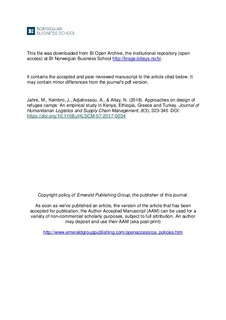| dc.contributor.author | Jahre, Marianne | |
| dc.contributor.author | Kembro, Joakim | |
| dc.contributor.author | Adjahossou, Anicet | |
| dc.contributor.author | Altay, Nezih | |
| dc.date.accessioned | 2018-11-09T11:27:08Z | |
| dc.date.available | 2018-11-09T11:27:08Z | |
| dc.date.created | 2018-10-11T22:42:10Z | |
| dc.date.issued | 2018 | |
| dc.identifier.citation | Journal of Humanitarian Logistics and Supply Chain Management, 2018, 8(3), 323-345 | nb_NO |
| dc.identifier.issn | 2042-6747 | |
| dc.identifier.issn | 2042-6755 | |
| dc.identifier.uri | http://hdl.handle.net/11250/2571782 | |
| dc.description.abstract | Purpose: The purpose of this paper is to link humanitarian logistics (HL) and supply chain risk management (SCRM) to provide an understanding of risk mitigation strategies that humanitarian organisations use, or could use, to improve their logistics preparedness.
Design/methodology/approach: Based on systematic reviews of RMS in SCRM and supply chain strategies (SCS) in HL literature, a framework is developed and used to review published case studies in HL.
Findings: The study finds that humanitarian actors use a number of the strategies proposed in the framework, particularly those related to strategic stocks, postponement, and collaboration. Strategies related to sourcing and procurement, however, especially those on supplier relationships, seem to be lacking in both research and practice.
Research limitations/implications: The study is based on secondary data and could be further developed through case studies based on primary data. Future studies should explore the generalisability of the findings.
Practical implications: Practitioners can use the framework to identify potential new SCS and how strategies can be combined. Findings can help them to understand the abnormal risks of main concern, how they may impact normal risks, and provide ideas on how to tackle trade-offs between different risks.
Social implications: The results can support improvements in humanitarian supply chains, which will provide affected people with rapid, cost-efficient, and better-adapted responses.
Originality/value: The paper connects SCRM and HL to develop a framework and suggests propositions on how humanitarian actors can mitigate supply chain risks. Questioning the focus on strategic stock it suggests complementary or alternative strategies for improving logistics preparedness. | nb_NO |
| dc.language.iso | eng | nb_NO |
| dc.publisher | Emerald | nb_NO |
| dc.title | Approaches on design of refugee camps – An empirical study in Kenya, Ethiopia, Greece and Turkey | nb_NO |
| dc.title.alternative | Perspectives on design of refugee camps – An empirical study in Kenya, Ethiopia, Greece and Turkey | nb_NO |
| dc.type | Journal article | nb_NO |
| dc.type | Peer reviewed | nb_NO |
| dc.description.version | acceptedVersion | nb_NO |
| dc.source.pagenumber | 323-345 | nb_NO |
| dc.source.volume | 8 | nb_NO |
| dc.source.journal | Journal of Humanitarian Logistics and Supply Chain Management | nb_NO |
| dc.source.issue | 3 | nb_NO |
| dc.identifier.doi | https://doi.org/10.1108/JHLSCM-12-2016-0043 | |
| dc.identifier.cristin | 1619871 | |
| dc.description.localcode | 1, Forfatterversjon | nb_NO |
| cristin.unitcode | 158,13,0,0 | |
| cristin.unitname | Institutt for regnskap, revisjon og foretaksøkonomi | |
| cristin.ispublished | true | |
| cristin.fulltext | postprint | |
| cristin.qualitycode | 1 | |
